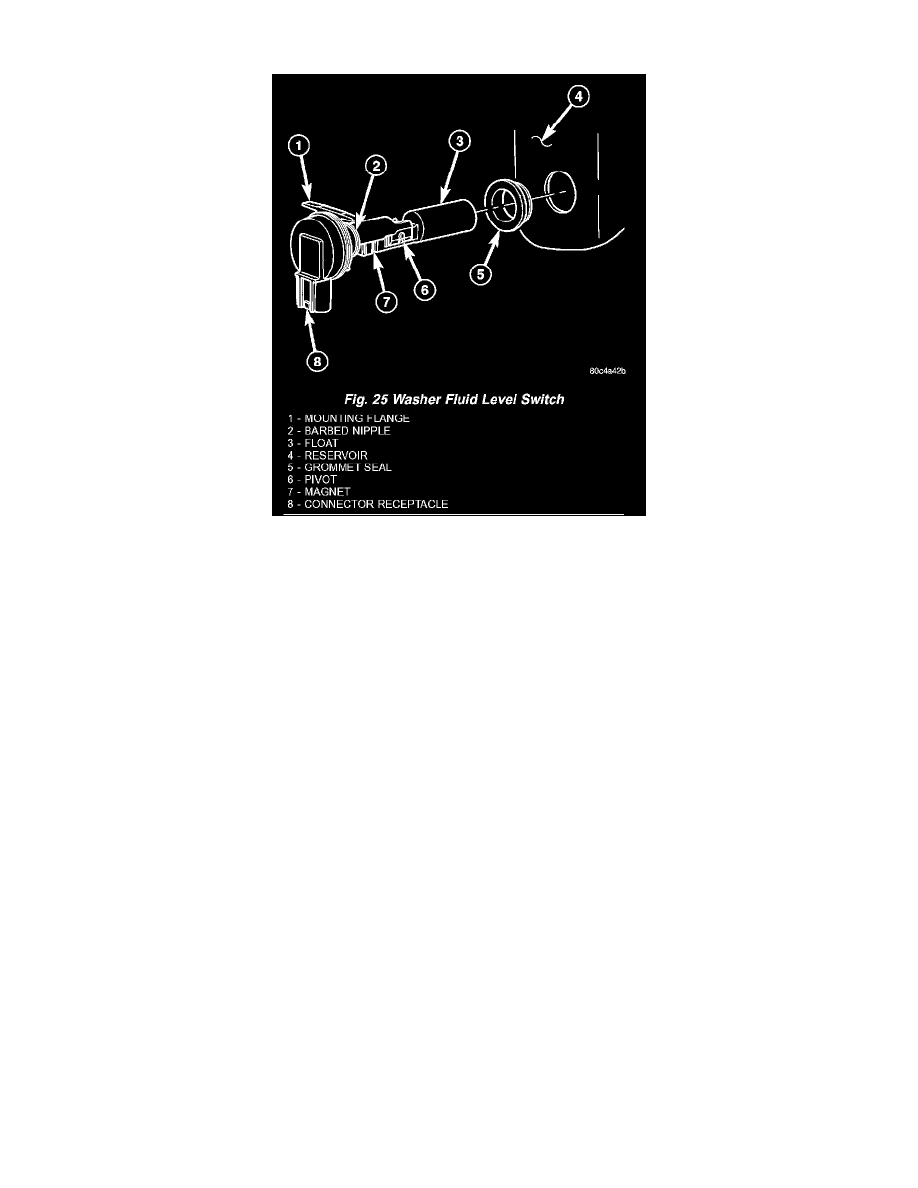Grand Cherokee 2WD V8-4.7L VIN J (2004)

Washer Fluid Level Switch: Description and Operation
Fig. 25 Washer Fluid Level Switch
WASHER FLUID LEVEL SWITCH
The washer fluid level switch is a single pole, single throw reed-type switch mounted at the front of the sump area near the bottom of the washer
reservoir, forward of the two washer pump/motors. Only the molded plastic switch mounting flange and the integral connector receptacle are visible
when the switch is installed in the reservoir. A short nipple formation extends from the inner surface of the switch mounting flange, and a barb on the
nipple near the switch mounting flange is pressed through a rubber grommet seal installed in the mounting hole of the reservoir. A small, molded
plastic float has two pivot pins near its center that are snapped into two receptacles near the ends of two stanchions that extend toward the float from
the switch nipple formation. A small magnet is secured within the end of the float nearest the switch nipple formation, and a reed switch is concealed
within the nipple. A diagnostic resistor is connected between the two switch terminals within the switch mounting flange. The washer fluid level
switch cannot be adjusted or repaired. If faulty or damaged, the switch must be replaced.
The washer fluid level switch uses a pivoting, oblong float to monitor the level of the washer fluid in the washer reservoir. The float contains a small
magnet. When the float pivots, the proximity of this magnet to a stationary reed switch within the nipple formation of the switch changes. When the
fluid level in the washer reservoir is at or above the float level, the float moves to a vertical position, the influence of the float magnetic field is
removed from the reed switch, and the normally open reed switch contacts open. When the fluid level in the washer reservoir falls below the level of
the pivoting float, the float moves to a horizontal position, the influence of the float magnetic field is applied to the reed switch, and the contacts of the
normally open reed switch close.
The washer fluid level switch is connected to the vehicle electrical system through a dedicated take out and connector of the left headlamp and dash
wire harness. The switch receives a five volt reference signal from the Body Control Module (BCM) through the washer fluid switch output circuit.
The switch is grounded at all times through another take out of the left headlamp and dash wire harness with a single eyelet terminal connector that is
secured under a ground screw near the top of the left front fender inner shield in the engine compartment.
When the switch closes, the BCM senses the voltage change on the circuit. The BCM is programmed to send low washer fluid messages to the
Electronic Vehicle Information Center (EVIC) over the Programmable Communications Interface (PCI) data bus. The EVIC is programmed to
respond to this message by displaying the Washer Fluid Low warning and sending a chime request message back to the BCM over the PCI data bus.
Then the BCM generates an audible chime tone warning.
A diagnostic resistor within the washer fluid level switch allows the BCM to monitor and diagnose this circuit. The BCM will store a Diagnostic
Trouble Code (DTC) for any fault that it detects. For retrieval of this fault information and further diagnosis of the washer fluid level switch, the
BCM, the EVIC, the PCI data bus, the BCM electronic message outputs to the EVIC that control the Low Washer Fluid indicator, or the EVIC
electronic message outputs to the BCM that control chime service, a DRBIII scan tool is required. Refer to the appropriate diagnostic information.
